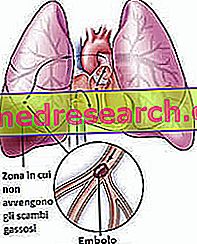Generality
Pulmonary embolism consists of the obstruction of a blood vessel that leads blood from the heart to the lungs, to oxygenate it. In other words, it is an occlusive block that is located in the pulmonary artery or in one of its branches.

Responsible for this block is a material, called embolus (usually a blood clot), which is transported from the blood to the pulmonary vessels.
The main cause of embolism is deep vein thrombosis; the latter is a pathological process that leads to the formation of a blood clot inside a vein, usually located at the level of the legs. This clot (called thrombus) can detach from the original site (from this moment it takes the name of embolus) and be transported from the blood to the pulmonary artery, causing its obstruction and the consequent embolism.
The typical symptoms of pulmonary embolism consist of: dyspnoea, chest pain, cough, cyanosis and cardiac arrhythmia.
The therapy is mainly based on the administration of anticoagulants; however, thrombolytics and more invasive treatments may also be needed.
What is pulmonary embolism?
The pulmonary embolism is a pathological condition marked by the obstruction of a blood vessel that carries deoxygenated blood (ie poor in oxygen) from the heart to the lungs. The vessel affected by the occlusion can be the pulmonary artery or its branching, while the obstruction is linked to the presence of an embolus.
An embolus is of the material (a blood clot, a lump of fat, an air bubble etc.) carried by the blood to a specific point where it stops, occluding the blood vessel and causing an embolism. If the affected vessel is the pulmonary artery we will have a reduction in the gas exchange taking place at the level of the alveoli, between blood and inhaled air.
EMBOLIA AND THROMBOSIS: GENERAL MEANING
Embolism and thrombosis are often confused for each other, however they do not represent the same pathological situation.
The term thrombosis indicates the presence of a blood clot, called thrombus, on the inner wall of a blood vessel (arterial or venous). If they reach a certain size, the thrombus can prevent normal blood flow and cause serious consequences.
The term embolism, instead, identifies the presence of a mobile body, called an embolus, carried by the blood. Emboli, such as thrombus, can partially or totally block blood circulation.
The confusion between thrombosis and embolism arises from the possibility that from the first condition the second arises: it is in fact possible for a thrombus to come apart giving rise to mobile blood clots (in other words to emboli). These, if they are not dissolved in time by the defensive systems of the organism, can be pushed by the blood up to a smaller vessel, in which they stop their run, affecting the flow of blood.
Embolism can therefore be considered a complication of thrombosis.
Epidemiology
According to American research, every year in the USA, pulmonary embolism affects around 600, 000 people, causing between 50, 000 and 200, 000 deaths.
From other surveys, still referred to the USA, it emerged that in the last 25 years the mortality rate has suffered a reduction from 6 to 2%.
For Italy, an incidence of 65, 000 cases per year has been calculated.
Causes
The obstruction of the pulmonary artery or its branching is due to the presence of an embolus, which depending on the case may consist of:
- A blood clot generated in some vein far from the heart and lungs (for example in the legs). This process is called deep vein thrombosis .
- An air bubble ( gaseous pulmonary embolism ).
- A lump of fat (fat pulmonary embolism ). The lumps of fat, which come from the fatty tissues of the body, can penetrate into the blood vessels following a serious traumatic injury, such as the fracture of a long bone in the body.
- A lump of amniotic fluid . It can occur in pregnant women.
- A foreign body (eg splinters or needles).
- Talc granules . Pulmonary embolism from talc granules is typical of people taking venous drugs.
- Parasites, such as tapeworms or heartworms, and microorganisms, such as pyogenic bacteria .
The blood clot formed by the effect of deep vein thrombosis represents the type of embolus most commonly causing pulmonary embolism.
DEEP VENOUS THROMBOSIS: THE CAUSES
The main factors that can determine the formation of one or more blood clots in a deep vein are: prolonged physical inactivity, the lesion of the blood vessel wall ( endothelial damage ) and the tendency to the formation of blood clots ( hypercoagulability ).
- Inactivity . The prolonged immobility causes blood to accumulate in the deep veins of the lower limbs (venous stasis), favoring the development of blood clots in the legs. This predisposition is further aggravated by the force of gravity, which hinders the return of venous blood to the heart
Deep vein thrombosis due to immobility is typical of individuals who spend many hours in a sitting position, travel long distances by air or by car, are forced into sickness, such as hospitalized patients, or have suffered a severe trauma or limb surgery lower.
- Blood vessel injury (or endothelial damage ). The lesion of the vessel wall gives rise to the local formation of blood clots, necessary to block the bleeding. Such clots could represent a danger and cause deep vein thrombosis, especially if the lesion is severe (as happens for example during a severe bone fracture, a deep muscle injury, a delicate surgery or a vasculitis).
- Hypercoagulability . The tendency to the formation of blood clots in arterial or venous vessels can be caused by a tumor (for example, of the pancreas, ovary or lungs), by a genetic / hereditary or acquired thrombophilia, by hypertension or from a heart failure.

RISK FACTORS
After several studies and after the analysis of many cases, the researchers identified several circumstances capable of favoring the onset of pulmonary embolism.
These circumstances are:
- Advanced age . Individuals most at risk are people over 60 years.
- A familial predisposition to episodes of thrombosis and embolism ( thromboembolism ).
- Obesity and overweight .
- Pregnancy . The risk exists because the presence of the fetus in the maternal uterus compresses the veins of the pelvic area, slowing the return of venous blood to the heart. Furthermore, during pregnancy, it is possible for a lump of amniotic fluid to transfer into the blood vessels.
- Cigarette smoke and, in general, any use made of tobacco .
- Taking the contraceptive pill or estrogen ( hormone replacement therapy ). This is one of the reasons why, before taking these drugs, it is advisable to seek medical attention.
Symptoms and Complications
The symptoms and signs of pulmonary embolism vary from patient to patient, depending on the extent of the obstruction (for example, if there are more occluding blood clots the situation is certainly more serious than when there is only one) and the general state of health of the patient (for example, the presence of cardiac disorders or tumors further complicates the situation).
In general, the typical expressions of a pulmonary embolism are:
- Dyspnea . It's the shortness of breath. Usually, it occurs after physical exertion, but in more severe cases it can also appear at rest.
- Chest pain . It is particularly marked after a deep breath, after eating, after a cough or after a flexion of the trunk.
- Cough . It can sometimes be accompanied by blood. In these cases, we speak of hemoptysis.
- Irregular heart beat and tachycardia
- Cyanosis
- Dizziness and dizziness
- Fainting
- Excessive sweating
If the symptoms are particularly marked, we speak of massive pulmonary embolism ; if the symptoms are moderate, one speaks instead of non-massive pulmonary embolism .
Warning: when pulmonary embolism is due to a deep vein thrombosis in the legs, these can appear sore, red and swollen.
WHEN TO REFER TO THE DOCTOR?

Figure: deep vein thrombosis in the right leg, indicated by the arrow indicating the characteristic swelling. From the site: wikipedia.org
Pulmonary embolism is a potentially very dangerous situation, as it could lead to the death of those affected. Therefore, the inexplicable presence of dyspnea, chest pain and hemoptysis should prompt you to contact your doctor immediately for a more thorough check.
Furthermore, it is important to remember that those who lead an extremely sedentary life should never neglect a possible swelling or pain in the legs, because they could represent the sign of a deep vein thrombosis and the prelude to pulmonary embolism.
PULMONARY EMBOLIA WITHOUT EVIDENT SYMPTOMS
Pulmonary embolisms can also be asymptomatic or cause only mild symptoms. This, however, does not mean that the situation is less dangerous, since the occlusion could however worsen at any moment.
COMPLICATIONS
If the obstruction occurs quickly and affects the pulmonary artery or its larger branches, pulmonary embolism can quickly cause the death of the affected subject.
If instead the obstruction is the result of a gradual process and involves secondary branches of the pulmonary artery (eg small capillaries), the embolism can lead to an increase in arterial pressure inside the lungs and in the right side of the heart.
This complication, with a degenerative character, is called pulmonary hypertension .
Continue: Pulmonary Embolism - Diagnosis and Treatment »



